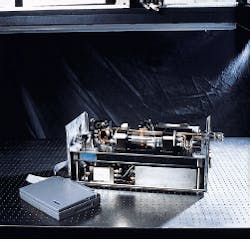Difference-frequency generation in periodically poled lithium niobate (PPLN) provides 4.6-µm infrared radiation for a compact laser-based sensor developed to measure real-time concentrations of trace gases such as carbon monoxide (CO). Konstatin Petrov, Yasu Mine, Robert Curl, and Frank Tittel from Rice University (Houston, TX) and John Graf from NASA Lyndon B. Johnson Space Center (JSC; Houston, TX) will describe the spectroscopic system and results obtained measuring CO concentrations during the Early Human Testing Phase 2A test at JSC this month at the 27th International Congress on Environmental Systems in Lake Tahoe, NV.
The system can measure CO levels between 0.1 and 10 parts per million (ppm; while signal averaging for 10 s) in ambient air with a precision of 0.001 ppm and an absolute accuracy of 0.6%. Such an instrument could be used on manned spacecraft for air-quality assessment.
Compact system design
Two interacting laser beams—a pump and a signal—are mixed in an appropriate crystal in the nonlinear difference-frequency generation process to create the infrared idler beam. Conventional birefringent nonlinear crystals must satisfy stringent phase-matching conditions for efficient generation of the idler beam, which restricts pump and signal frequencies available. Periodically poled nonlinear materials (see Laser Focus World, May 1997, p. 105) such as PPLN are engineered with a periodic domain grating that—in a process termed quasi-phase-matching—relaxes these conditions. Flexibility in the choice of pump and signal wavelengths facilitates instrument design.
The portable gas sensor measures only 1 × 1 × 2 ft (see Fig. on p. 32). A 700-mW diode-pumped monolithic-ring Nd:YAG laser (Model 126; Lightwave Electronics; Mountain View, CA) serves as the signal laser, while a single-frequency 100-mW GaAlAs diode laser (Model 5412; SDL Inc.; San Jose, CA) is the pump. The 1064.5-nm signal beam and the 865-nm pump beam are combined in a dichroic beamsplitter and focused into an uncoated 19 × 11 × 0.5-mm PPLN crystal (Crystal Technology; Palo Alto, CA) with domain period gratings ranging from 22.4 to 23.1 µm in 0.1-µm steps. The optimum room-temperature grating period for generation of 4.6-µm infrared output was found to be 22.9 µm.
Typically, an idler beam with about 4.4 µW of power was produced. The sensor contained a compact multipass gas cell (Model 5611; New Focus; Santa Clara, CA) that was aligned to give an 18.3-m pathlength. A miniature Peltier-cooled mercury cadmium telluride detector was configured to measure the power of the idler beam after the gas cell (typically around 1.5 µW). Direct optical-absorption measurements of the idler beam were used to calculate the CO concentration, and depending on how many averages of the detector voltage were captured, the data could be updated every 1-80 s.
The gas sensor was calibrated with an absorption measurement of an air sample with known CO concentration: 9.00۪.05 ppm. The researchers then used the calibration data to measure another calibrated sample with CO content of 1.030۪.055 ppm—their result was 1.0559۪.0008 ppm; the standard deviation of individual measurements (0.0008 ppm) is much smaller than the 0.6% initial accuracy of the calibration sample. Further work ensured the long-term stability of the system through two weeks of continuous operation, and the researchers developed data-fitting algorithms that accounted for variations in operating frequency and output power.
The sensor was field tested at a 20-ft-diameter chamber outfitted for life-support research and development at JSC last January. Four human subjects participated in a 60-day closed-chamber test, and the laser-based sensor tracked a daily increase in CO in chamber air over a 16-day period.
The average rate of increase in the CO concentration was 0.41 ppm/day, equivalent to 120 mg of CO produced in the chamber every day (see Fig. 2). The sensor measured a rapid exponential decrease in concentration beginning at 6:00 pm on January 24, which is when the Trace Contaminant Control System was turned on. This catalytic oxidizer removes CO from air within the chamber.Further plans for the sensor include its modification to detect other contaminants simultaneously. In addition to CO, carbon dioxide, methane, and formaldehyde could be detected with a tunable system. The researchers plan on incorporating an external-cavity diode laser tunable from 816 to 865 nm. With the 1064.5-nm signal laser, it should be possible to generate an idler output between 3.5 and 4.6 µm. They expect this system to achieve detection limits of better than 0.01 ppm for all these species.
About the Author
Heather W. Messenger
Executive Editor
Heather W. Messenger (1955-1998) was Executive Editor for Laser Focus World.

